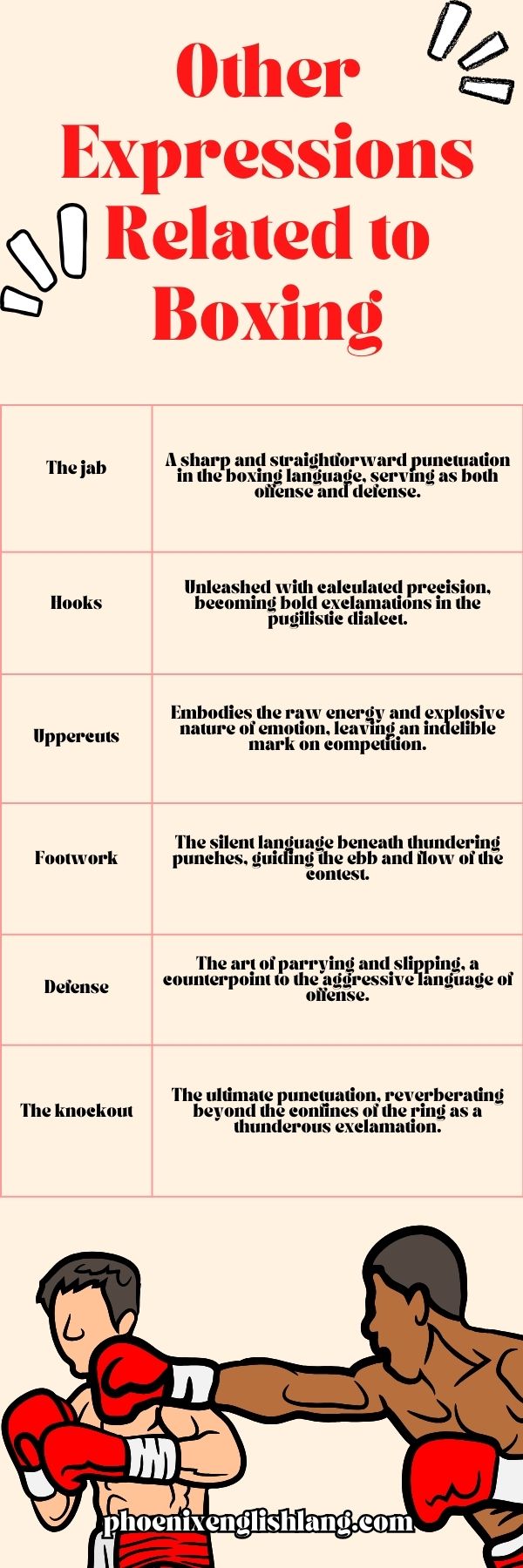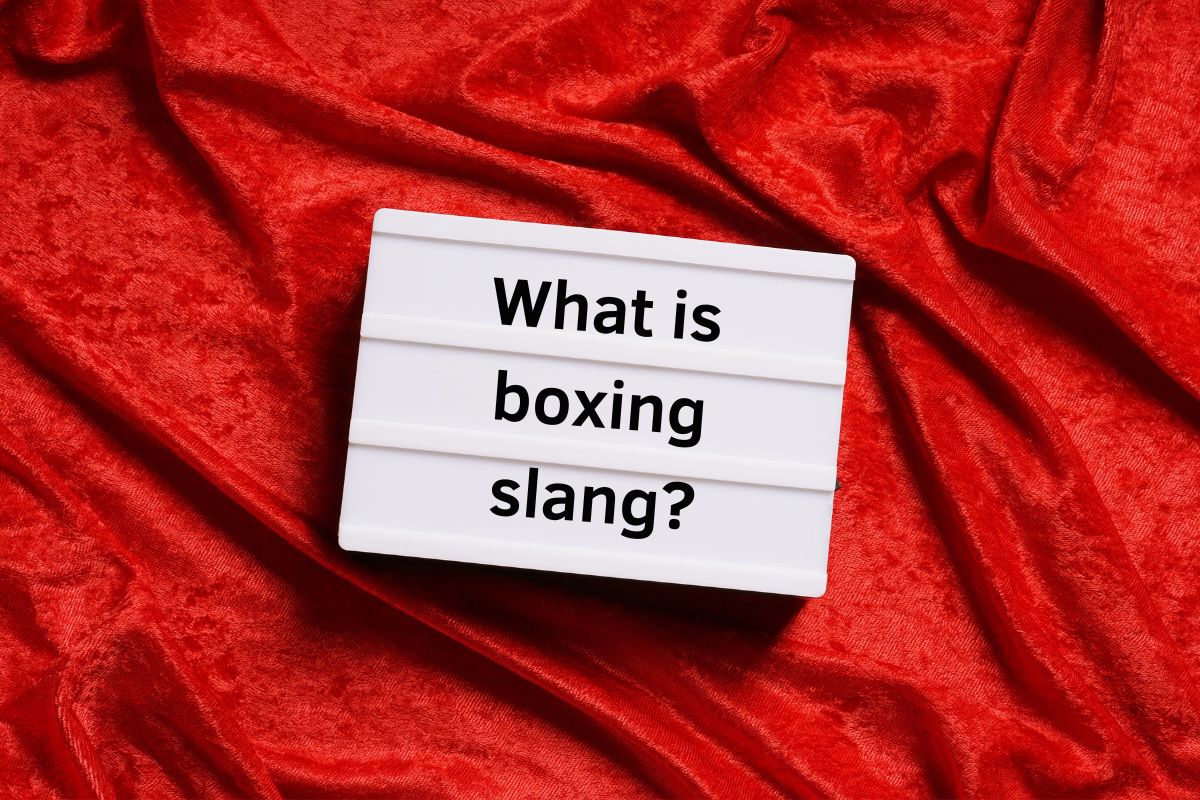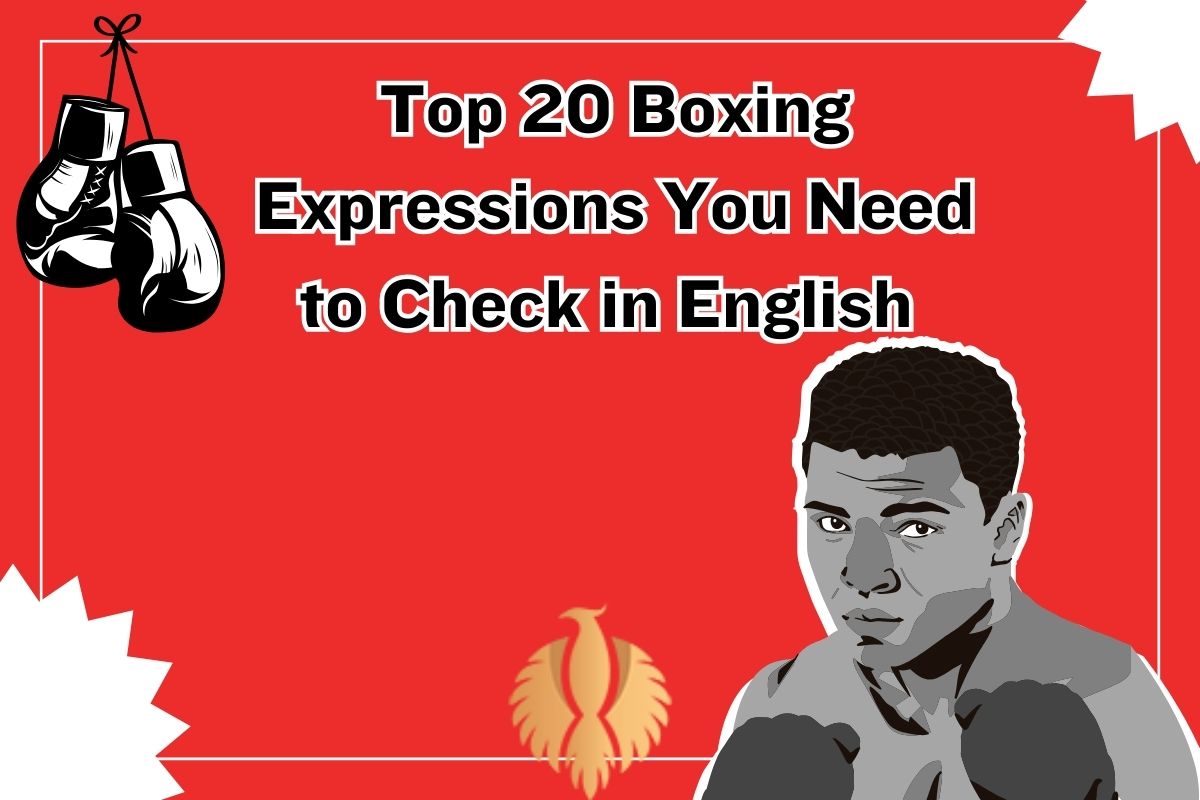Boxing is a combat sport that has been practiced for centuries and has become a popular form of expression.
It is a physical and mental discipline that requires strength, agility, and strategy. In the ring, boxers use their fists to strike their opponents, aiming to score points or knock them out.
However, boxing is not just about throwing punches; it is also about self-expression and the ability to convey emotions and messages through the art of fighting. Continue reading this article if you’re interested to learn top boxing expressions!
Boxing is often referred to as the “sweet science” because it combines the physicality of a sport with the finesse and technique of an art form.
Each boxer has their own unique style, which is a reflection of their personality and individuality. Some fighters are known for their aggressive and hard-hitting approach, while others rely on speed and footwork to outmaneuver their opponents.
The way a boxer moves, dodges, and counterattacks can convey a range of emotions, from confidence and dominance to fear and vulnerability.
Boxing also provides an outlet for self-expression beyond the physical aspect. Many boxers use their platform to advocate for social issues or to raise awareness about important causes.
Muhammad Ali, for example, used his fame and success in the ring to speak out against racial inequality and the Vietnam War. His famous quote, “I am the greatest,” not only showcased his confidence but also symbolized his defiance against societal norms and expectations.
In addition to self-expression, boxing also allows individuals to push their limits and overcome challenges. The rigorous training and discipline required in boxing can build character and resilience.
Boxers often face setbacks and defeats, but they learn to get back up, adapt their strategies, and continue fighting. The determination and perseverance required in boxing can translate into other areas of life, teaching valuable life lessons about resilience, discipline, and perseverance.
Furthermore, boxing provides a platform for personal growth and self-discovery. As boxers train and compete, they learn more about their strengths, weaknesses, and capabilities.
They develop a deep understanding of their bodies, honing their physical skills and pushing their limits.
Boxing requires mental focus and concentration, which can enhance self-awareness and mindfulness.
Through the challenges and triumphs of boxing, individuals can discover their true potential and develop a sense of self-confidence and empowerment.
Boxing is not just a sport but a form of expression. It allows individuals to showcase their unique style, convey emotions, and advocate for important causes.
Beyond the physicality, boxing builds character, resilience, and self-discovery. Whether in the ring or outside of it, boxing provides a platform for individuals to express themselves and make a meaningful impact.
Here are Top 20 Boxing Expressions
| 1. Throw in the towel – to give up or concede defeat |
| 2. Knockout – a punch that renders an opponent unconscious and ends the fight |
| 3. Jab – a quick, straight punch with the lead hand |
| 4. Hook – a punch thrown in a circular motion, targeting the opponent’s side |
| 5. Uppercut – an upward punch aimed at the opponent’s chin |
| 6. Counterpunch – a punch thrown in response to an opponent’s attack |
| 7. Rope-a-dope – a strategy where a boxer leans against the ropes, absorbing punches to tire out the opponent |
| 8. Haymaker – a powerful, wide swing punch |
| 9. Footwork – the movement and positioning of a boxer’s feet |
| 10. Clinch – when two boxers hold each other to prevent punches or regain composure |
| 11. Southpaw – a left-handed boxer |
| 12. Bob and weave – a defensive technique involving ducking and swaying to avoid punches |
| 13. Combination – a series of punches thrown in quick succession |
| 14. Counterpuncher – a boxer who relies on defensive skills and counters with precise punches |
| 15. Brawler – a boxer who prefers a rough, aggressive fighting style |
| 16. Featherweight – a weight class in boxing for fighters weighing between 122 and 126 pounds |
| 17. Middleweight – a weight class in boxing for fighters weighing between 154 and 160 pounds |
| 18. Heavyweight – the highest weight class in boxing, typically for fighters weighing over 200 pounds |
| 19. Title bout – a fight for a championship belt or title |
| 20. Pound-for-pound – a ranking system that compares boxers regardless of weight class, based on skill and ability |
You might also enjoy: 100 ;Home; Idioms and Expressions In 2024
Other Expressions Related to Boxing

The jab, a sharp and straightforward punctuation in the boxing language, serves as both an offensive tool and a defensive shield.
It speaks of control and measurement, a versatile expression that sets the tone for the entire conversation within the ring. A well-executed jab is akin to a well-crafted sentence, setting up combinations and dictating the rhythm of the bout.
Hooks and uppercuts, unleashed with calculated precision, become bold exclamations in this pugilistic dialect.
These power punches embody the raw energy and explosive nature of emotion, leaving an indelible mark on the canvas of competition. Each blow tells a story of strength, strategy, and the relentless pursuit of victory.
Footwork, the silent language beneath the thundering punches, speaks volumes about a fighter’s finesse and adaptability.
It is the poetry of movement, a nuanced expression that guides the ebb and flow of the contest. The dance of footwork echoes the strategic dialogue between two pugilists, as they navigate the ring with grace and determination.
Defense, a subtle but crucial aspect of boxing expression, is the art of parrying and slipping, a counterpoint to the aggressive language of offense.
It signifies resilience and adaptability, showcasing a fighter’s ability to absorb and deflect the verbal onslaught of punches, much like a skilled orator deflects critiques.
The knockout, the ultimate punctuation in a boxing conversation, is a thunderous exclamation point that reverberates beyond the confines of the ring.
It is the climax, the crescendo of a narrative built on sweat, strategy, and the unyielding pursuit of victory. Yet, even in defeat, the act of rising from the canvas embodies a resilient epilogue, a testament to the enduring spirit of a pugilist.
In the realm of boxing, expression is not confined to words but extends to the eloquence of movement, the cadence of punches, and the unspoken language of the ring.
It is a visceral and unfiltered dialogue, where fighters communicate their stories, aspirations, and resilience through the medium of the sweet science.
What is boxing slang?

Boxing, like many sports, has its own unique slang and terminology that adds flavor to the discourse within the boxing community. Here are some common boxing slang terms:
- **Pugilist:** A formal term for a boxer, highlighting the sport’s historical connection to the art of pugilism.
- **Canvasback:** Refers to a boxer who has been knocked down and is on the canvas.
- **Southpaw:** A left-handed boxer, where the lead hand is the right hand, and the stance is opposite to the conventional (orthodox) stance.
- **Clinch:** When boxers hold each other to avoid punches, leading to a temporary pause in the action.
- **Bob and Weave:** Defensive movements involving bending at the waist and moving the upper body to avoid punches.
- **Rope-a-Dope:** A strategy where a boxer rests against the ropes, allowing the opponent to tire themselves out before launching a counterattack.
- **Kidney Punch:** A punch targeting the kidneys, which is illegal in modern boxing.
- **Bum’s Rush:** A quick and aggressive attack, often catching an opponent off guard.
- **Chin Check:** A punch thrown to test the opponent’s ability to take a punch.
- **In the Pocket:** Fighting at close range, within striking distance.
- **Glass Jaw:** A boxer who is easily knocked out or stunned by punches to the jaw.
- **Feint:** A deceptive movement or action to mislead an opponent, often used to set up another punch.
- **Saved by the Bell:** When a boxer is saved from a potential knockout because the round ends.
- **Cutman:** A person responsible for treating a boxer’s cuts and swelling between rounds.
- **Throw in the Towel:** An action taken by a boxer’s corner to concede defeat by literally throwing a towel into the ring.
These terms contribute to the rich and colorful language of boxing, reflecting the history, strategy, and nuances of the sport.
You might also enjoy: Top 30 Advanced Adjectives In English [2024 Update]
What are some of boxers quotes?

- **Muhammad Ali:** “Float like a butterfly, sting like a bee.”
- **Mike Tyson:** “Everyone has a plan until they get punched in the mouth.”
- **Floyd Mayweather Jr.:** “I’m not in this sport to take punishment. I’m in this sport to give punishment.”
- **Manny Pacquiao:** “I want to be remembered as a good person and a great fighter.”
- **Sugar Ray Robinson:** “To be a champ, you have to believe in yourself when nobody else will.”
- **George Foreman:** “Boxing is like jazz. The better it is, the less people appreciate it.”
- **Joe Frazier:** “You can map out a fight plan or a life plan. But when the action starts, you’re down to your reflexes.”
- **Roy Jones Jr.:** “I was always confident in my skills. I wasn’t worried about being a great boxer; I was worried about being the best.”
- **Cassius Clay (before becoming Muhammad Ali):** “I’m not the greatest, I’m the double greatest.”
- **Evander Holyfield:** “It’s not the size of a man but the size of his heart that matters.”
- **Rocky Marciano:** “Hit the ball over the fence and you can take your time going around the bases.”
- **Sonny Liston:** “I’m the king of the world! I’m the king of the world!”
- **Jake LaMotta:** “I fought Sugar Ray so often, I almost got diabetes.”
- **Bernard Hopkins:** “It’s not bragging if you can back it up.”
- **Lennox Lewis:** “I’m just a kid from London who grew up too fast.”
These quotes capture the essence of the fighters, their mindset, and the unique challenges and triumphs that come with the sport of boxing.
Top 40 English Pronunciation Guidelines You Must Know [2024]
What is the term dirty boxing?
Dirty boxing refers to a style of boxing that involves using unconventional or borderline illegal tactics within the rules of the sport.
This can include techniques like hitting below the belt, holding and hitting, headbutting, low blows, kidney punches, and other maneuvers that might be considered unsportsmanlike.
While boxing has strict rules and regulations to ensure fair play and safety, some fighters may employ dirty boxing tactics to gain an advantage or disrupt their opponent’s strategy.
However, such tactics can lead to penalties, point deductions, or disqualification if the referee deems them excessive or dangerous.
It’s important to note that dirty boxing is generally frowned upon within the professional boxing community, as it goes against the principles of fair competition and sportsmanship.
Fighters are expected to adhere to the established rules and engage in a contest that emphasizes skill, strategy, and respect for the opponent.
What is a 7 punch in boxing?

In boxing, the term “7 punch” typically doesn’t refer to a specific punch or combination.
The numbering system in boxing is used to designate different punches, but it can vary depending on the gym or coach.
The basic numbering system commonly includes jabs (1), straight rights or lefts (2), hooks (3), and uppercuts (4).
If someone mentions a “7 punch,” it’s possible they are using a specific gym’s or coach’s numbering system that may not be universally recognized.
It’s always best to clarify with the specific coach or individual using the term to ensure accurate understanding of the combination or punch they are referring to.
You might also enjoy: Top 25 most used words with suffix less
What does Gypsy mean in boxing?
In boxing, the term “Gypsy” is often associated with a distinctive style of fighting that is characterized by unorthodox movements, elusive footwork, and an unpredictable approach. This style is not only about physical techniques but also embodies a certain mindset and heritage, particularly linked to the Romani and Traveller communities.
1.Unorthodox Movements
Boxers characterized by a “Gypsy” style frequently utilize unconventional techniques that can perplex and outsmart their adversaries. Such movements are generally not part of traditional boxing training; instead, they are cultivated through individual experience and a profound comprehension of the sport.
This distinctive approach may encompass surprising angles of attack, atypical defensive strategies, and a flexible, adaptable fighting style.
2.Elusive Footwork
The distinctive footwork characteristic of the “Gypsy” boxing style is marked by its elusiveness. Boxers employ their agility and swiftness to evade their opponents’ strikes while strategically positioning themselves for successful counterattacks. This footwork transcends mere speed; it encompasses timing and accuracy, enabling the boxer to dictate the rhythm and spacing of the bout.
3.Unpredictable Fighting Approach
The unpredictability of the “Gypsy” style makes it difficult for opponents to anticipate and counter. This approach involves a mix of offensive and defensive tactics that keep the opponent guessing. By constantly changing their rhythm and strategy, “Gypsy” style boxers can create openings and exploit weaknesses in their opponents’ defenses.
4.Cultural Heritage
The designation “Gypsy” in the context of boxing is intricately connected to the cultural legacy of the Romani and Traveller communities. These communities have a rich history of participation in the sport, producing numerous distinguished fighters.
A prominent figure is Tyson Fury, referred to as “The Gypsy King,” who takes pride in his Traveller background. Fury’s boxing technique showcases several traits commonly attributed to the “Gypsy” style, such as his unconventional movements and agile footwork.
5.Psychological Edge
Boxers who adopt the “Gypsy” style often gain a psychological edge over their opponents. The unpredictability and fluidity of their movements can be intimidating and frustrating for opponents, leading to mistakes and openings that the “Gypsy” style boxer can exploit. This mental aspect of the style is as important as the physical techniques, contributing to the overall effectiveness of the approach.
6.Training and Development
Developing a “Gypsy” style requires a combination of natural talent, rigorous training, and a deep understanding of boxing. Fighters often learn these techniques through years of practice and experience, often outside the traditional boxing gym environment. This style is passed down through generations, with young fighters learning from older, more experienced boxers within their community.
What is ducking in boxing?
In boxing, the term “ducking” carries two distinct meanings, both of which are integral to the sport. It can refer to the strategic avoidance of a fight against a particular opponent, or it can describe a defensive maneuver used within the ring. Understanding both contexts is essential for a comprehensive grasp of the term.
1.Ducking as Avoiding a Fight
In the world of professional boxing, “ducking” often refers to a fighter’s decision to avoid or evade a match against a specific opponent. This strategic move can be motivated by various factors:
- Perceived Threat: A boxer might choose to duck a fight if they perceive the opponent as a significant threat. This could be due to the opponent’s superior skills, physical advantages, or an intimidating track record.
- Career Strategy: Fighters and their management teams carefully plan their careers, aiming for title shots and lucrative matches. Facing a particularly challenging opponent at the wrong time could jeopardize these plans. By ducking a fight, a boxer might be preserving their chances for future opportunities.
- Injury and Readiness: Sometimes, a fighter might not feel physically or mentally prepared to face a tough opponent. Ducking in this context can be a way to avoid unnecessary risk and ensure they are at their best for critical matches.
While ducking can be seen as a tactical decision, it often carries a negative connotation. Fans and critics may view it as a sign of cowardice or lack of confidence. However, from a strategic standpoint, it can be a smart move to protect a fighter’s career and long-term goals.
2.Ducking as a Defensive Maneuver
Within the ring, “ducking” refers to a defensive technique where a boxer bends at the waist to avoid an opponent’s punches. This movement resembles a duck lowering its head, hence the name. Ducking is a fundamental part of a boxer’s defensive skill set and is crucial for several reasons:
- Avoiding Punches: By ducking, a boxer can evade incoming punches, reducing the risk of getting hit. This is especially useful against jabs and hooks aimed at the head.
- Creating Counterattack Opportunities: Effective ducking can put a boxer in a position to launch a counterattack. By slipping under a punch, they can quickly come up with a powerful counterpunch.
- Maintaining Balance and Positioning: Ducking helps a boxer maintain their balance and positioning in the ring. It allows them to stay close to their opponent while avoiding strikes, keeping them in an advantageous position for both defense and offense.
Technique and Training
Mastering the ducking technique requires extensive training and practice. Boxers must develop strong core muscles and excellent timing to execute the move effectively. Coaches often incorporate ducking drills into training routines to help fighters improve their reflexes and defensive capabilities.

Hi, welcome to my blog! My name is Omid and I am thrilled to have you here! I am an English language teacher with 12 years of experience and hold multiple international certifications (TESOL, IELTS, TOEFL, PTE, CELTA). Additionally, I hold a PhD in Applied Linguistics with a specialization in Teaching English as a Second Language (TESL), which fuels my passion for teaching English and assisting others in mastering the language. To me, nothing is more rewarding than helping individuals enhance their English language abilities through various methods. So, let’s embark on this journey of learning English together.




